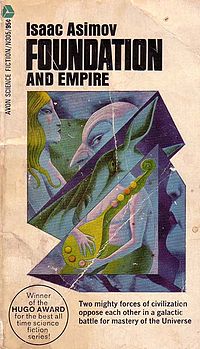- Mule (Foundation)
-
 The Mule playing his Psycholyre on a paperback cover of Foundation and Empire from the 1960s
The Mule playing his Psycholyre on a paperback cover of Foundation and Empire from the 1960s
The Mule is a fictional character from Isaac Asimov's Foundation series.[1] One of the greatest conquerors the galaxy has ever seen, he is a mentalic who has the ability to reach into the minds of others and "adjust" their emotions, individually or en masse, using this capability to forcibly enlist them to his cause. Individuals who have their emotions adjusted behave otherwise normally, with their logic, memories and personality intact; even if they are aware of the manipulation, they are unable to desire to resist it. This gives the Mule the capacity to disrupt Seldon's plan by invalidating Seldon's assumption that no single individual could have a measurable effect on galactic socio-historical trends on their own, due to the plan relying on the predictability of action of very large numbers of people.
Contents
Fictional history
The Mule establishes his empire incrementally, using past conquests to aid new ones: first by mentally converting a pirate band to his allegiance, then a whole planet, then the militarily powerful kingdom of Kalgan, which he obtains by mentally converting the warlord of the planet Kalgan, and then the Foundation. The Mule sets up his own short-lived Galactic Empire — the "Union of Worlds", styling himself "First Citizen of the Union" and making Kalgan its capital planet. Leading up to, during, and for a good time after the Mule's conquest of the Foundation and its trade confederacy, almost no one ever actually sees the Mule or knows what he looks like.
The Foundation, after the death of the Empire, is the sole supplier of nuclear weaponry in the galaxy, and using this asset the Mule begins rapidly conquering surrounding territories, all of which lack nuclear power, sweeping aside the remnants of the Galactic Empire centered around Neotrantor.
The Mule's conquest is amazingly fast: he defeats the Foundation and establishes the Union of Worlds after only five years. Then, just as suddenly, and seemingly randomly, he stops his advance and settles into a five year period of consolidation. This is actually because the Mule fears the mysterious Second Foundation, which is rumoured to be capable of defeating a mentalic individual like himself. According to a hint given by Hari Seldon, the Second Foundation was founded at "the opposite end of the galaxy" from the First Foundation, which was itself founded on the distant galactic rim planet Terminus. However, the true location of the Second Foundation is a total mystery and popular sentiment is that it does not exist. Nevertheless, the Mule launches repeated expeditions in search of the Second Foundation during this period of consolidation.
These expeditions, particularly the last, led by Han Pritcher and Bail Channis, are very nearly successful. Ultimately, however, the Second Foundation succeeds in defeating the Mule, turning him into a relatively harmless individual, lacking ambition, and no threat to the Seldon Plan.
Nature
The Mule's name is a reference to the sterility of mules, since he too is genetically sterile. Without a child available as a successor, the Mule's empire ends soon after his death. No reference is ever given about any other name for him besides "The Mule". The origin of who gave him that name is never given.
Physically, the Mule is a freak, with a long nose (at least three inches) tightly stretched facial skin, and a spindly body. His joints jut out from his diminutive musculature. The Mule's meagerness is glandular and untreatable. Furthermore, his limbs meet at awkward angles, giving the general impression of a scarecrow assembled poorly. His eyes are described as deep brown and perpetually sad. In Second Foundation, it is revealed that the Mule dies in his thirties as a result of his poor health.
As a result of the Mule's freakish appearance, his childhood is one of torment and alienation. The Mule becomes aware of his great mental powers in his twenties, and develops a desire to compensate for his earlier life by taking revenge on humanity.
Seldon Plan Disturbed by Mule
The Mule is a central character in both Foundation and Empire and Second Foundation. Foundation's Edge reveals that he originally came from the planet Gaia, but was regarded as an aberration on a world where mental powers were being developed for benevolent ends.
"No matter what was the way but in a crisis of Psychohistorical development times- a "Mutant" entered in the Theories and wanted a position for himself and his disturb was highest in the Seldon Plan. The Seldon Plan faces great challenges and may even be wrong..... Mutant The Mule failed to find it the first time- but now he is certain he knows where it lies, even he knew his theory was wrong..... We are given vague clues that is a danger to the Seldon Plan, Perhaps the most "Disturbing Point" in the Psychohistorical Theory and in the book is the thought of......" -Second Foundation, Foundation and Empire, Foundation's EdgeOrigins
According to his autobiography In Memory Yet Green, Asimov modeled his physical appearance on Leonard Meisel, a friend at the World War II-era Navy Yard in Philadelphia. In keeping with the Foundation series being based on the Roman Empire, the Mule has historical parallels with both Attila the Hun and Charlemagne, and he has also been compared to the Roman Emperor Augustus as well as Hitler.
Notes
- ^ Greiner, Pat. (1985) "Magnifico Gigantus: Asimov's Shakespearean fool." Extrapolation 26(1): 29-35.
Isaac Asimov's Foundation series Asimov writings Others' writings Characters Planets Trantor • Galactic EmpireOther Preceded by The Robot Series and The Empire Series Categories:- Foundation universe characters
- Fictional dictators
- Fictional mutants
- Fictional telepaths
- Individual mules
Wikimedia Foundation. 2010.

